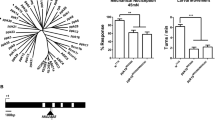Summary
A new mutant ofParamecium tetraurelia, k-shyA, was characterized behaviorally and electrophysiologically. The mutant cell exhibited prolonged backward swimming episodes in response to depolarizing conditions. Electrophysiological comparison of k-shyA with wild type cells under voltage clamp revealed that the properties of three Ca2+-regulated currents were altered in the mutant. (i) The voltage-dependent Ca2+ current recovered from Ca2+-dependent inactivation two- to 10-fold more slowly than wild type. Ca2+ current amplitudes were also reduced in the mutant, but could be restored by EGTA injection. (ii) The decay of the Ca2+-dependent K+ tail current was slower in the mutant. (iii) The decay of the Ca2+-dependent Na+ tail current was also slower in the mutant. All other membrane properties studied, including the resting membrane potential and resistance and the voltage-sensitive K+ currents, were normal in k-shyA. Considered together, these observations are consistent with a defect in the ability of k-shyA to reduce the free intracellular Ca2+ concentration following stimulation. The possible targets of the genetic lesion and alternative explanations are discussed. The k-shy mutants may provide a useful tool for molecular and physiological analyses of the regulation of Ca2+ metabolism inParamecium.
Similar content being viewed by others
References
Brehm, P., Eckert, R. 1978. Calcium entry leads to inactivation of calcium current inParamecium.Science 202:1203–1206
Brehm, P., Eckert, R., Tillotson, D. 1980. Calcium mediated inactivation of calcium currents inParamecium.J. Physiol. (London) 306:193–203
Browning, J.L., Nelson, D.L. 1976. Biochemical studies of the excitable membrane ofParamecium aurelia. I.45Ca fluxes across resting and excited membranes.Biochim. Biophys. Acta 448:338–351
Campbell, A.K. 1983. Intracellular Calcium. Its Universal Role as Regulator. John Wiley and Sons, New York
Doughty, M.J., Kaneshiro, E.S. 1983. Divalent cation ATPase activities associated with cilia and other subcellular fractions ofParamecium: An electrophoretic characterization on triton-polyacrylamide gels.J. Protozool. 30(3)565–573
Eckert, R. 1972. Bioelectric control of cillary activity.Science 176:473–481
Eckert, R., Naitoh, Y., Machemer, H. 1976. Calcium in the bioelectric and motor functions ofParamecium.In: Calcium in Biological Systems. C.J. Duncan, editor. pp. 233–255. Cambridge University Press, New York
Haga, N., Forte, M., Ramanathan, R., Hennessey, T., Takahashi M., Kung, C. 1984. Characterization and purification of a soluble protein controlling Ca-channel activity inParamecium.Cell 39:71–78
Hennessey, T.M., Kung, C. 1985. Slow inactivation of the calcium current ofParamecium is dependent on voltage and not internal calcium.J. Physiol. (London) 365:165–179
Hinrichsen, R.D., Burgess-Cassler, A., Soltvedt, B.C., Hennessey, T., Kung, C. 1986. Restoration by calmodulin of a Ca2+-dependent K+ current missing in a mutant ofParamecium.Science 232:503–506
Hinrichsen, R.D., Kung, C. 1984. Genetic analysis of axonemal mutants inParamecium tetraurelia defective in their response to calcium.Genet. Res. 43:11–20
Hinrichsen, R.D., Saimi, Y., Ramanathan, R., Burgess-Cassler, A., Kung, C. 1985. A genetic and biochemical analysis of behavior inParamecium.In: Sensing Responses in Microorganisms. M. Eisenbach and M. Balaban, editors. pp. 145–157. Elsevier Science, Amsterdam
Ikemoto, N. 1982. Structure and function of the calcium pump protein of sarcoplasmic reticulum.Annu. Rev. Physiol. 44:297–317
Izumi, A., Nakaoka, Y. 1987. cAMP-mediated inhibitory effect of calmodulin antagonists on ciliary reversal ofParamecium.Cell Motil. Cytoskeleton 7:154–159
Kung, C. 1971. Genic mutations with altered system of excitation inParamecium tetraurelia. II. Mutagenesis, screening, and genetic analysis of the mutants.Genetics 69:29–45
Kung, C., Saimi Y. 1982. The physiological basis of taxes inParamecium.Annu. Rev. Physiol. 44:519–534
Martinac, B., Hildebrand, E. 1981. Electrically induced Ca++-transport across the membrane ofParamecium caudatum measured by means of flow-through technique.Biochim. Biophys. Acta 649:244–252
Muto, Y., Nozowa, Y. 1984. Biochemical characterization of (Ca2++Mg2+)-ATPase ofTetrahymena microsomes.Biochim. Biophys. Acta 777:64–74
Nelson, D.L., Kung, C. 1979. Behavior ofParamecium: Chemical, physiological, and genetic studies.In: Taxis and Behavior, Receptors and Recognition. Series B, Vol. 5, pp. 77–99. G.L. Hazelbauer, editor. Chapman and Hall, London
Oertel, D., Schein, S.J., Kung, C. 1977. Separation of membrane currents using aParamecium mutant.Nature (London) 268: 120–124
Oertel, D., Schein, S.J., Kung, C. 1978. A potassium conductance activated by hyperpolarization inParamecium.J. Membrane. Biol. 43:169–185
Otter, T., Satir, B.H., Satir, P. 1984. Trifluoperazine-induced changes in swimming behavior ofParamecium: Evidence for two sites of drug action.Cell Motil. 4:249–267
Riddle, L.M., Rauh, J.J., Nelson, D.L. 1982. A Ca2+-activated ATPase specifically released by Ca2+ shock fromParamecium tetraurelia.Biochim. Biophys. Acta 688:525–540
Saimi, Y. 1986. Calcium-dependent sodium currents inParamecium: Mutational manipulations and effects of hyper- and depolarization.J. Membrane Biol. 92:227–236
Saimi, Y., Hinrichsen, R.D., Forte, M., Kung, C. 1983. Mutant analysis shows that the Ca2+-induced K+ current shuts off one type of excitation inParamecium.Proc. Natl. Acad. Sci. USA 80:5112–5116
Saimi, Y., Kung, C. 1980. A Ca-activated Na-current inParamecium.J. Exp. Biol. 88:305–325
Satow, Y., Kung, C. 1979. Voltage sensitive Ca2+ channels and the transient inward current inParamecium tetraurelia.J. Exp. Biol. 78:149–161
Satow, Y., Kung, C. 1980a. Ca-induced K outward current inParamecium tetraurelia.J. Exp. Biol. 88:293–303
Satow, Y., Kung, C. 1980b. Membrane currents of pawn mutants of the pwA group inParamecium tetraurelia.J. Exp. Biol. 84:57–71
Schatzman, H.J., 1985. Calcium extrusion across the plasma membrane by the calcium pump and the Ca−Na exchange system.In: Calcium and Cell Physiology. D. Marme, editor. pp. 18–52. Springer Verlag, New York
Sonneborn, T.M. 1970. Methods inParamecium research.In: Methods in Cell Physiology. Vol. 4, pp. 241–331. D.M. Prescott, editor. Academic, New York
Sonneborn, T.M. 1975.Paramecium aurelia.In: Handbook of Genetics Vol. II, pp. 469–594, K.C. King, editor. Plenum, New York
Tiggerman, R., Plattner, H. 1982. Possible involvement of a calmodulin-regulated Ca2+-ATPase in exocytosis performance inParamecium tetraurelia cells.FEBS Lett 148:226–230
Travis, S.M., Nelson, D.L. 1986. Characterization of a Ca2+ or Mg2+-ATPase of the excitable ciliary membrane fromParamecium tetraurelia: Comparison with a soluble ATPase.Biochim. Biophys. Acta 862:39–48
Author information
Authors and Affiliations
Rights and permissions
About this article
Cite this article
Evans, T.C., Hennessey, T. & Nelson, D.L. Electrophysiological evidence suggests a defective Ca2+ control mechanism in a newParamecium mutant. J. Membrain Biol. 98, 275–283 (1987). https://doi.org/10.1007/BF01871189
Received:
Revised:
Issue Date:
DOI: https://doi.org/10.1007/BF01871189




